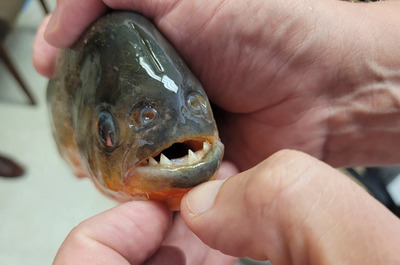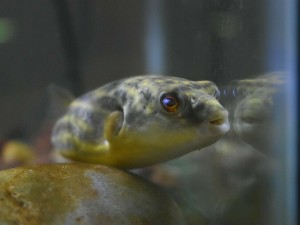
Are piranhas venomous or poisonous to humans?
 Piranhas do not produce venom or poison because they do not have the physical or biochemical mechanisms to do so. Venomous animals produce toxins in specialized glands and deliver them through specialized structures such as fangs or spines, while poisonous animals have toxic substances within their body tissues or skin that can be harmful if ingested or touched. Piranhas lack these specialized structures and have not been found to produce any toxins that could be considered venom or poison.
Piranhas do not produce venom or poison because they do not have the physical or biochemical mechanisms to do so. Venomous animals produce toxins in specialized glands and deliver them through specialized structures such as fangs or spines, while poisonous animals have toxic substances within their body tissues or skin that can be harmful if ingested or touched. Piranhas lack these specialized structures and have not been found to produce any toxins that could be considered venom or poison.Instead, piranhas rely on their powerful jaws and sharp teeth to catch and kill their prey. Their teeth are constantly growing and are replaced as they wear down, allowing them to maintain their sharpness and effectiveness as hunting tools. Piranhas typically attack in groups, using their teeth to tear flesh and remove scales from their prey.
While piranhas are not venomous or poisonous, their powerful bite can be quite painful and may cause significant injury. It is important to exercise caution when swimming or fishing in areas where piranhas are present, and to avoid provoking or harassing these animals to minimize the risk of injury.
What species of fish in South America are dangerous to humans?
One example is the electric eel, which is found in the Amazon Basin and other freshwater systems in South America. The electric eel produces a powerful electric shock that it uses both for hunting prey and for self-defense. While the shock itself is not venomous or poisonous, it can be quite strong and may cause injury or even death in humans.
Electric eels, also known as freshwater eels, are native to the Amazon Basin and other freshwater systems in South America. Despite their name, they are not true eels but belong to the order Gymnotiformes, which includes other species of electric fish.
Electric eels are capable of producing electric shocks of up to 600 volts, making them one of the most powerful electric generators in the animal kingdom. They use their electric organs, which make up around 80% of their body, for both hunting prey and self-defense. When threatened or attacked, electric eels can produce a series of high-voltage shocks that can stun or incapacitate their predators.
Electric eels are carnivorous and feed primarily on fish, although they will also eat invertebrates and small mammals. They use their electric fields to locate their prey, and can even sense the electrical signals produced by the muscles of other animals.
Despite their formidable reputation, electric eels are not typically aggressive towards humans and will only use their electric shock as a defense mechanism. However, it is important to exercise caution when swimming or fishing in areas where electric eels are present, as their electric shocks can be quite powerful and may cause significant injury or even death.
Electric eels are capable of generating electrical shocks for extended periods of time, allowing them to immobilize their prey or defend themselves against predators. They are able to regenerate their electric organs throughout their lives, which helps to maintain their ability to produce electric shocks even as they age.
Overall, electric eels are fascinating and unique animals that play an important role in the freshwater ecosystems of South America. While they can be dangerous to humans in certain situations, they are generally not considered a significant threat and are a valuable subject of scientific study and observation.
Another example is the catfish species known as the candiru, or toothpick fish. This fish is found in the Amazon Basin and is known for its ability to swim up the urethra of humans and other animals, causing painful and potentially serious injury. While the candiru is not venomous, its presence in the urethra can cause significant harm.
The candiru, also known as the toothpick fish or vampire fish, is a parasitic catfish species native to the Amazon Basin in South America. It is a small fish, typically only a few centimeters in length, and is known for its ability to swim up the urethra of humans and other animals.
While the exact frequency of candiru attacks on humans is unclear, they are known to occur, particularly in areas where people swim or bathe in rivers. The fish is attracted to the scent of urine and can become lodged in the urethra, causing intense pain, bleeding, and potentially serious injury.
The candiru is not venomous, but its presence in the urethra can cause significant harm. Removing the fish can be difficult and may require surgery, and in some cases, the damage caused by the fish can be permanent.
There are several myths surrounding the candiru, including the belief that it can leap out of the water and enter the human body through any orifice. While these stories are generally considered to be exaggerated or false, the fact remains that the candiru is a dangerous and potentially harmful fish.
To avoid being attacked by candiru, it is recommended to avoid urinating in rivers or standing water where the fish may be present. Additionally, wearing tight-fitting clothing or using a urinary catheter may help to reduce the risk of a candiru attack.
Despite its reputation as a dangerous fish, the candiru plays an important role in the ecosystem of the Amazon Basin, serving as a food source for other fish and helping to control the population of certain species.
 There are also several species of poisonous fish found in South America, including the pufferfish and the venomous scorpionfish. These fish produce toxic substances in their tissues that can be harmful or even deadly if ingested. It is important to exercise caution when handling or consuming these types of fish and to avoid eating any fish that may be contaminated or improperly prepared.
There are also several species of poisonous fish found in South America, including the pufferfish and the venomous scorpionfish. These fish produce toxic substances in their tissues that can be harmful or even deadly if ingested. It is important to exercise caution when handling or consuming these types of fish and to avoid eating any fish that may be contaminated or improperly prepared.Pufferfish, also known as blowfish or balloonfish, are a group of fish that are found in both saltwater and freshwater habitats around the world. In South America, several species of pufferfish are found in the Amazon Basin and other freshwater systems.
Pufferfish are known for their ability to inflate themselves to many times their normal size by filling their stomach with water or air. This behavior is used as a defense mechanism to deter predators, and it also makes the fish more difficult to swallow if they are caught.
In addition to their unique defense mechanism, pufferfish are also known for their poisonous flesh. Many species of pufferfish produce a toxin called tetrodotoxin, which is a potent neurotoxin that can cause paralysis and death in humans and other animals. The toxin is found primarily in the liver, ovaries, and skin of the fish, and it is not destroyed by cooking or freezing.
Despite their toxicity, some species of pufferfish are considered a delicacy in certain parts of the world, including Japan, where they are known as fugu. In order to safely prepare and consume pufferfish, specialized training and certification are required, as the process of removing the toxic parts of the fish is highly regulated.
In South America, several species of pufferfish are found in the Amazon Basin, including the spotted puffer, the red-bellied puffer, and the marbled puffer. While these fish are not commonly consumed by humans, they are an important part of the freshwater ecosystem and play a role in controlling the populations of other fish and invertebrates.